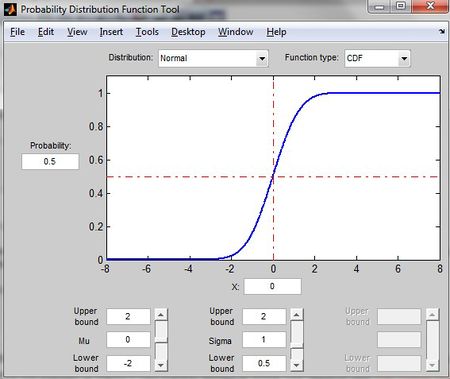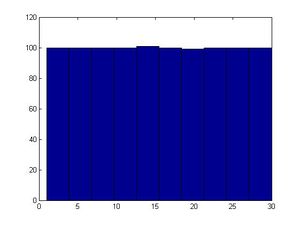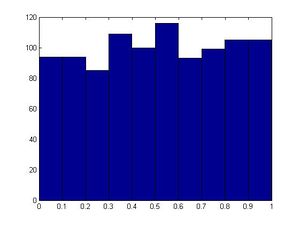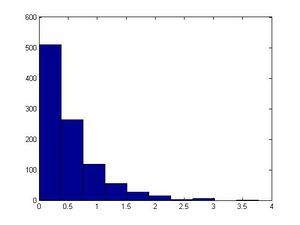stat340s13: Difference between revisions
No edit summary |
|||
| Line 99: | Line 99: | ||
=== Introduction === | === Introduction === | ||
There are camps debating about sampling. Some people believe that activities such as rolling a dice and flipping a coin are not truly random but are '''deterministic''' – the result can be reliably calculated using things such as physics and math. | |||
A computer cannot generate truly random numbers since computers can only run algorithms, which are deterministic in nature. They can, however, generate '''Pseudo Random Numbers'''; numbers that seem random but are actually deterministic. Although the Pseudo Random Numbers are deterministic, these numbers have a sequence of value and all of them have the appearances of being independent uniform random variables. | A computer cannot generate truly random numbers since computers can only run algorithms, which are deterministic in nature. They can, however, generate '''Pseudo Random Numbers'''; numbers that seem random but are actually deterministic. Although the Pseudo Random Numbers are deterministic, these numbers have a sequence of value and all of them have the appearances of being independent uniform random variables. | ||
=== Multiplicative Congruential Algorithm === | === Multiplicative Congruential Algorithm === | ||
This is | This is a simple algorithm used to generate uniform, pseudo random numbers. It is also referred to as the Linear or Mixed Congruential Methods. We define the Linear Congruential Method to be x<sub>k+1</sub>=(a*x<sub>k</sub> + b) mod m. Given a "seed" x<sub>0</sub>, we can obtain values for x<sub>1</sub>, x<sub>2</sub>, ..., x<sub>n</sub> recursively. The Multiplicative Congruential Method may also refer to the special case where b=0.<br /> | ||
Note that if you take a number x, then divided by m. The remainder (please see the graph below) is a number between 0 and m-1. <br /> | |||
We use operator "mod" to represent the expression, which is x mod m. <br /> | |||
[[File:1.png]] | |||
'''Algorithm 1'''<br /> | '''Algorithm 1'''<br /> | ||
| Line 114: | Line 119: | ||
Step 2: 1 = 1 mod 3<br /> | Step 2: 1 = 1 mod 3<br /> | ||
Step 3: 1 = 1 mod 3<br /> | Step 3: 1 = 1 mod 3<br /> | ||
... | |||
This method generates a sequence of identical integers, hence we need a better algorithm.<br /> | This method generates a sequence of identical integers, hence we need a better algorithm.<br /> | ||
| Line 126: | Line 132: | ||
This method generates a sequence with a repeating cycle of two integers.<br /> | This method generates a sequence with a repeating cycle of two integers.<br /> | ||
'''MatLab for Multiplicative Congruential Algorithm:'''<br /> | (if people choose numbers properly, they could get a random sequence of numbers. However, how do we find the value of a,b, and m? At the very least m should be a very '''large''' number. The larger m is, the more possibility people get a random sequence of numbers. This is easier to solve in Matlab.) <br /> | ||
'''MatLab Instruction for Multiplicative Congruential Algorithm:'''<br /> | |||
Before you start:<br /> | Before you start:<br /> | ||
<pre> | <pre> | ||
| Line 142: | Line 150: | ||
</pre> | </pre> | ||
''(Note: Keep repeating this command over and over again and you will seem to get random numbers – this is how the command rand works in a computer.)<br /><br /> | ''(Note: <br /> | ||
1. Keep repeating this command over and over again and you will seem to get random numbers – this is how the command rand works in a computer. <br /> | |||
2. There is a function called RAND to generate a number between 0 and 1. | |||
3. If we would like to generate 1000 and more numbers, we could use a '''for''' loop)<br /><br /> | |||
<pre> | <pre> | ||
| Line 161: | Line 172: | ||
This algorithm involves three integer parameters a, b, and m and an initial value, x<sub>0</sub> called seed. A sequence of numbers is defined by x | This algorithm involves three integer parameters a, b, and m and an initial value, x<sub>0</sub> called '''seed'''. A sequence of numbers is defined by x<sub>k+1</sub> = a*x<sub>k</sub> + b mod m. Mod m means take the remainder after division by m. <br /> | ||
Note: For some bad a and b, the histogram may not be uniformly distributed.<br /> | Note: For some bad a and b, the histogram may not be uniformly distributed.<br /> | ||
Revision as of 16:51, 13 May 2013
Computer Simulation of Complex Systems (Stat 340 - Spring 2013)
Introduction, Class 1 - Tuesday, May 7
{{
Template:namespace detect
| type = style | image = | imageright = | style = | textstyle = | text = This article may require cleanup to meet Wikicoursenote's quality standards. The specific problem is: use math environment and LaTex notations for formulas. For example instead of y=1-e^(-λx) write [math]\displaystyle{ y=1-e^{-\lambda x} }[/math]. Please improve this article if you can. | small = | smallimage = | smallimageright = | smalltext = }}
Course Instructor: Ali Ghodsi
Lecture:
001: TTh 8:30-9:50 MC1085
002: TTh 1:00-2:20 DC1351
Tutorial:
2:30-3:20 Mon M3 1006
TA(s):
Lu Cheng Monday 3:30-5:30 pm M3 3108 space 2
Han ShengSun Tuesday 4-6 pm M3 3108 space 2
Yizhou Fang Wednesday 1-3 pm M3 3108 space 1
Huan Cheng Thursday 3-5 pm M3 3111 space 1
Wu Lin Friday 11am - 1pm M3 3108 space 1
Four Fundamental Problems
1. Classification: Given an input object X, we have a function which will take in this input X and identify which 'class (Y)' it belongs to (Discrete Case)
(For example, an image of a fruit can be classified, through some sort of algorithm to be a picture of either an apple or an orange.)
2. Regression: Same as classification but in the continuous case except y is discrete
3. Clustering: Use common features of objects in same class or group to form clusters.(in this case, x is given, y is unknown)
4. Dimensionality Reduction (aka Feature extraction, Manifold learning)
Applications
Most useful when structure of the task is not well understood but can be characterized by a dataset with strong statistical regularit y
Examples:
- Computer Vision, Computer Graphics, Finance (fraud detection), Machine Learning
- Search and recommendation (eg. Google, Amazon)
- Automatic speech recognition, speaker verification
- Text parsing
- Face identification
- Tracking objects in video
- Financial prediction(e.g. credit cards)
- Fraud detection
- Medical diagnosis
Course Information
General Information
- No required textbook
- Recommended: "Simulation" by Sheldon M. Ross
- Computing parts of the course will be done in Matlab, but prior knowledge of Matlab is not essential (will have a tutorial on it)
- First midterm will be held on Monday, June 17 from 2:30 to 3:30
- Announcements and assignments will be posted on Learn.
- Other course material on: http://wikicoursenote.com/wiki/
- Log on to both Learn and wikicoursenote frequently.
- Email all questions and concerns to UWStat340@gmail.com. Do not use your personal email address!
Wikicourse note (10% of final mark):
When applying an account in the wikicourse note, please use the quest account as your login name while the uwaterloo email as the registered email. This is important as the quest id will use to identify the students who make the contributions.
Example:
User: questid
Email: questid@uwaterloo.ca
After the student has made the account request, do wait for several hours before students can login into the account using the passwords stated in the email. During the first login, students will be ask to create a new password for their account.
As a technical/editorial contributor: Make contributions within 1 week and do not copy the notes on the blackboard.
Must do both All contributions are now considered general contributions you must contribute to 50% of lectures for full marks
- A general contribution can be correctional (fixing mistakes) or technical (expanding content, adding examples, etc) but at least half of your contributions should be technical for full marks
Do not submit copyrighted work without permission, cite original sources. Each time you make a contribution, check mark the table. Marks are calculated on honour system, although there will be random verifications. If you are caught claiming to contribute but didn't, you will lose marks.
Tentative Marking Scheme
| Item | Value |
|---|---|
| Assignments (~6) | 30% |
| WikiCourseNote | 10% |
| Midterm | 20% |
| Final | 40% |
Comments
To pass the course, you need to pass the final exam
Sampling (Generating random numbers), Class 2 - Thursday, May 9
Introduction
There are camps debating about sampling. Some people believe that activities such as rolling a dice and flipping a coin are not truly random but are deterministic – the result can be reliably calculated using things such as physics and math.
A computer cannot generate truly random numbers since computers can only run algorithms, which are deterministic in nature. They can, however, generate Pseudo Random Numbers; numbers that seem random but are actually deterministic. Although the Pseudo Random Numbers are deterministic, these numbers have a sequence of value and all of them have the appearances of being independent uniform random variables.
Multiplicative Congruential Algorithm
This is a simple algorithm used to generate uniform, pseudo random numbers. It is also referred to as the Linear or Mixed Congruential Methods. We define the Linear Congruential Method to be xk+1=(a*xk + b) mod m. Given a "seed" x0, we can obtain values for x1, x2, ..., xn recursively. The Multiplicative Congruential Method may also refer to the special case where b=0.
Note that if you take a number x, then divided by m. The remainder (please see the graph below) is a number between 0 and m-1.
We use operator "mod" to represent the expression, which is x mod m.

Algorithm 1
xk+1 = xk mod m
Example
Let x0 = 10, m = 3
Step 1: 1 = 10 mod 3
Step 2: 1 = 1 mod 3
Step 3: 1 = 1 mod 3
...
This method generates a sequence of identical integers, hence we need a better algorithm.
Algorithm 2 (Multiplicative Congruential Algorithm)
xk+1 = (a*xk+b) mod m
Example
Let a = 2, b = 1, m = 3, x0 = 10
Step 1: 0 = (2*10+1) mod 3
Step 2: 1 = (2*0+1) mod 3
Step 3: 0 = (2*1+1) mod 3
This method generates a sequence with a repeating cycle of two integers.
(if people choose numbers properly, they could get a random sequence of numbers. However, how do we find the value of a,b, and m? At the very least m should be a very large number. The larger m is, the more possibility people get a random sequence of numbers. This is easier to solve in Matlab.)
MatLab Instruction for Multiplicative Congruential Algorithm:
Before you start:
>>clear all >>close all
>>a=17 >>b=3 >>m=31 >>x=5 >>mod(a*x+b,m) ans=26 >>x=mod(a*x+b,m)
(Note:
1. Keep repeating this command over and over again and you will seem to get random numbers – this is how the command rand works in a computer.
2. There is a function called RAND to generate a number between 0 and 1.
3. If we would like to generate 1000 and more numbers, we could use a for loop)
>>a=13 >>b=0 >>m=31 >>x(1)=1 >>for ii=2:1000 x(ii)=mod(a*x(ii-1)+b,m); end >>size(x) ans=1 1000 >>hist(x)
(Note: The semicolon after the x(ii)=mod(a*x(ii-1)+b,m) ensures that Matlab will not show the entire vector of x. It will instead calculate it internally and you will be able to work with it. Adding the semicolon to the end of this line reduces the run time significantly.)
This algorithm involves three integer parameters a, b, and m and an initial value, x0 called seed. A sequence of numbers is defined by xk+1 = a*xk + b mod m. Mod m means take the remainder after division by m.
Note: For some bad a and b, the histogram may not be uniformly distributed.
Example: a=13, b=0, m=31
The first 30 numbers in the sequence are a permutation of integers for 1 to 30 and then the sequence repeats itself. Values are between 0 and m-1. If the values are normalized by dividing by m-1, then the result is numbers uniformly distributed in the interval [0,1]. There are only a finite number of values (30 in this case). In Matlab, you can use function "hist(x)" to see if it is uniformly distributed.
Examples:[From Textbook]
If x0=3 and xn=(5xn-1+7)mod 200, find x1,...,x10.
Solution:
x1= (15+7) mod 200= 22
x2= 117 mod 200= 117
x3= 592 mod 200 = 192
x4= 2967 mod 200= 167
x5= 14842 mod 200= 42
x6= 74217 mod 200 = 17
x7= 371092 mod 200= 92
x8= 1855467 mod 200= 67
x9= 9277342 mod 200 = 142
x10= 46386717 mod 200 = 117
Comments:
Typically, it is good to choose m such that m is large, and m is prime. Careful selection of parameters 'a' and 'b' also helps generate relatively "random" output values, where it is harder to identify patterns. For example, when we used a non prime number such as 40 for m, our results were not satisfactory in producing an output resembling a uniform distribution.
The computed values are between 0 and m-1. If the values are normalized by dividing by m-1, their result is numbers uniformly distributed on the interval [0,1].
From the example shown above, we can see to create a good random number sequence generator, we need to select a large m. As the xn value is dependent on the (5xn-1+7)value, such that the value it can be is between 0 to m after that a value will be repeated; and once this happens the whole sequence will began to repeat. Thus, if we want to create large group of random number, it is better to have large m such that the random value generated will not be repeated after several recursion.
Example:
For xn = (2xn-1+1) mod 3 where x0=2, x1 = 5 mod 3 = 2
Notice that, with the small value m, the random number generated repeated itself is faster than when the value is large enough.
For many years the “rand” function in Matlab used this algorithm with these parameters
A=75=16807, b=0, m=231 -1=2147483647 – recommended in a 1988 paper, "Random Number Generators: Good Ones Are Hard To Find" by Stephen K. Park and Keith W. Miller (Important part is that m should be large)
Inverse Transform Method
This method is useful for generating types of distribution other than uniform distribution, such as exponential distribution and normal distribution. Exponential distribution has the property that generated numbers are frequently close to 0. Normal distribution has the property that generated numbers are frequently close to its mean.
Theorem:
Take U ~ U[0,1] and let x=F-1(U)
Then x has distribution function F(.)
Where F(x) = P(X<=x) cdf; F-1(U) denotes the inverse function of F(.) Or that F(x)=U -> x=F-1(U)
Proof of the theorem:
[math]\displaystyle{ F(x) = P(X\leq x) }[/math]
[math]\displaystyle{ =P(F^{-1}(U)\leq x) }[/math]
[math]\displaystyle{ =P(F(F^{-1}(U))\leq F(x)) }[/math] #Applying F, which is monotonic, to both sides
[math]\displaystyle{ =P(U\leq F(x)) }[/math]
[math]\displaystyle{ =F(x) }[/math] #Because [math]\displaystyle{ Pr(U\leq y)=y }[/math],since U is uniform on the unit interval
F(.) is a monotonic function, which is a function that strictly increasing or decreasing.
Example: [math]\displaystyle{ f(x) = \lambda e^{-\lambda x} }[/math]
[math]\displaystyle{ F(x)= \int_0^x f(x) dx }[/math]
[math]\displaystyle{ = \int_0^x \lambda e ^{-\lambda x}\ dx }[/math]
[math]\displaystyle{ = \frac{\lambda}{-\lambda}\, e^{-\lambda x}\, | \underset{0}{x} }[/math]
[math]\displaystyle{ = -e^{\lambda x} + e^0 }[/math]
[math]\displaystyle{ =1 - e^{- \lambda x} }[/math]
[math]\displaystyle{ y=1-e^{- \lambda x} }[/math]
[math]\displaystyle{ 1-y=e^{- \lambda x} }[/math]
[math]\displaystyle{ x=-ln(1-y)/{\lambda} }[/math]
[math]\displaystyle{ y=-ln(1-x)/{\lambda} }[/math]
[math]\displaystyle{ F^{-1}(x)=-ln(1-x)/{\lambda} }[/math]
Step 1: Draw U ~U[0,1];
Step 2: [math]\displaystyle{ x=\frac{-ln(1-U)}{\lambda} }[/math]
Example 2: Given a CDF of X: F(x) = x5, transform U~U[0,1]. Sol: Let y=x5, solve for x => x=y(1/5) =>F-1(x) = x(1/5) Hence, to obtain a value of x from F(x), we first set u as an uniform distribution, then obtain the inverse function of F(x), and set x= u(1/5)
In Matlab, you can use functions:
"who" to see what variables you have defined
"clear all" to clear all variables you have defined
"close all" to close all figures
MatLab for Inverse Transform Method:
>>u=rand(1,1000) >>hist(u) #will generate a fairly uniform diagram
#let λ=2 in this example; however, you can make another value for λ
>><math>x=\frac{(-log(1-u))}{2}</math>;
>>size(x) #1000 in size
>>figure
>>hist(x) #exponential
Limitations:
1. This method is flawed since not all functions are invertible nor monotonic.
2. It may be impractical since some CDF's and/or integrals are not easy to compute.
Probability Distribution Function Tool in MATLAB
>>disttool #shows different distributions
This command allows users to explore the effect of changes of parameters on the plot of either a CDF or PDF.



